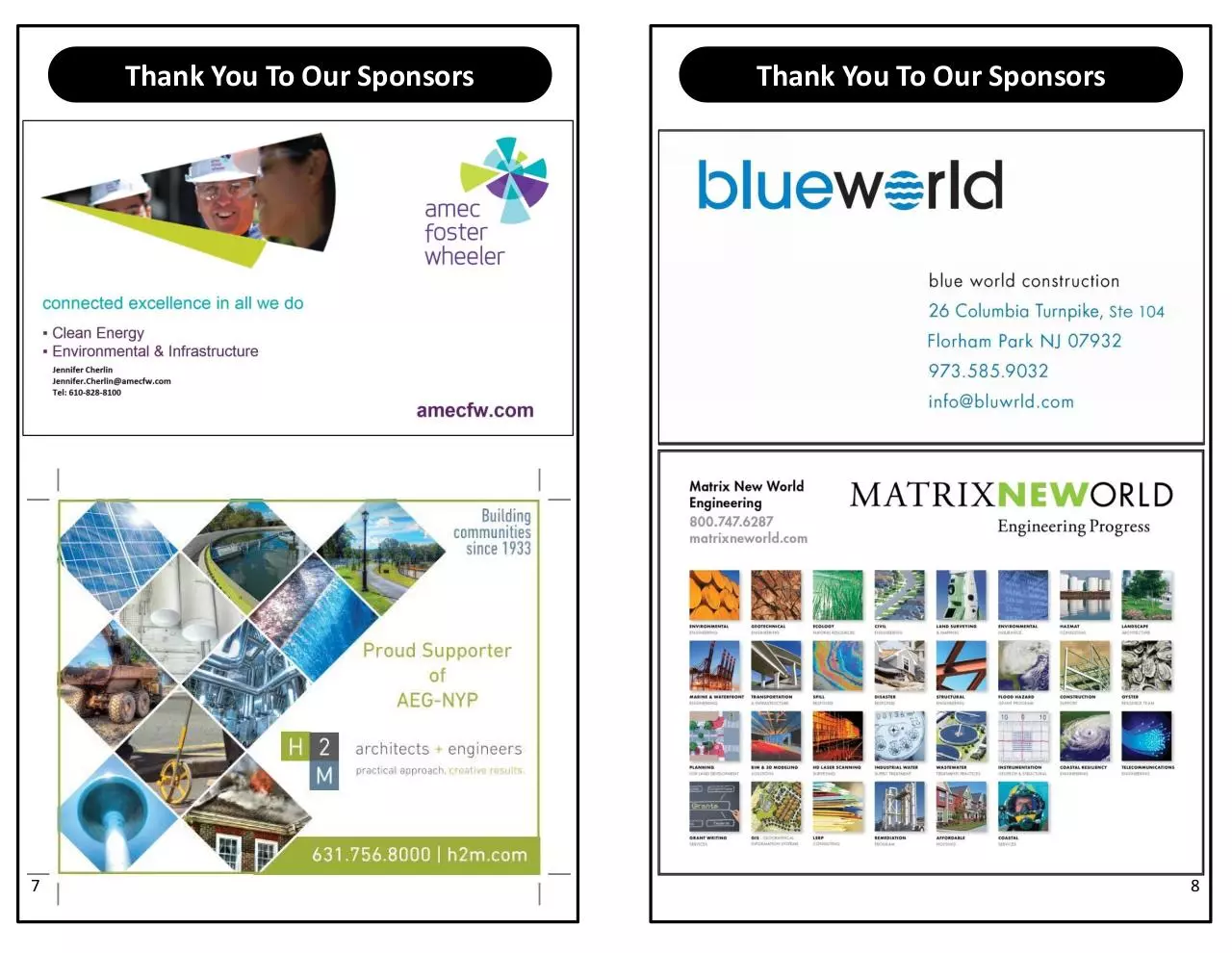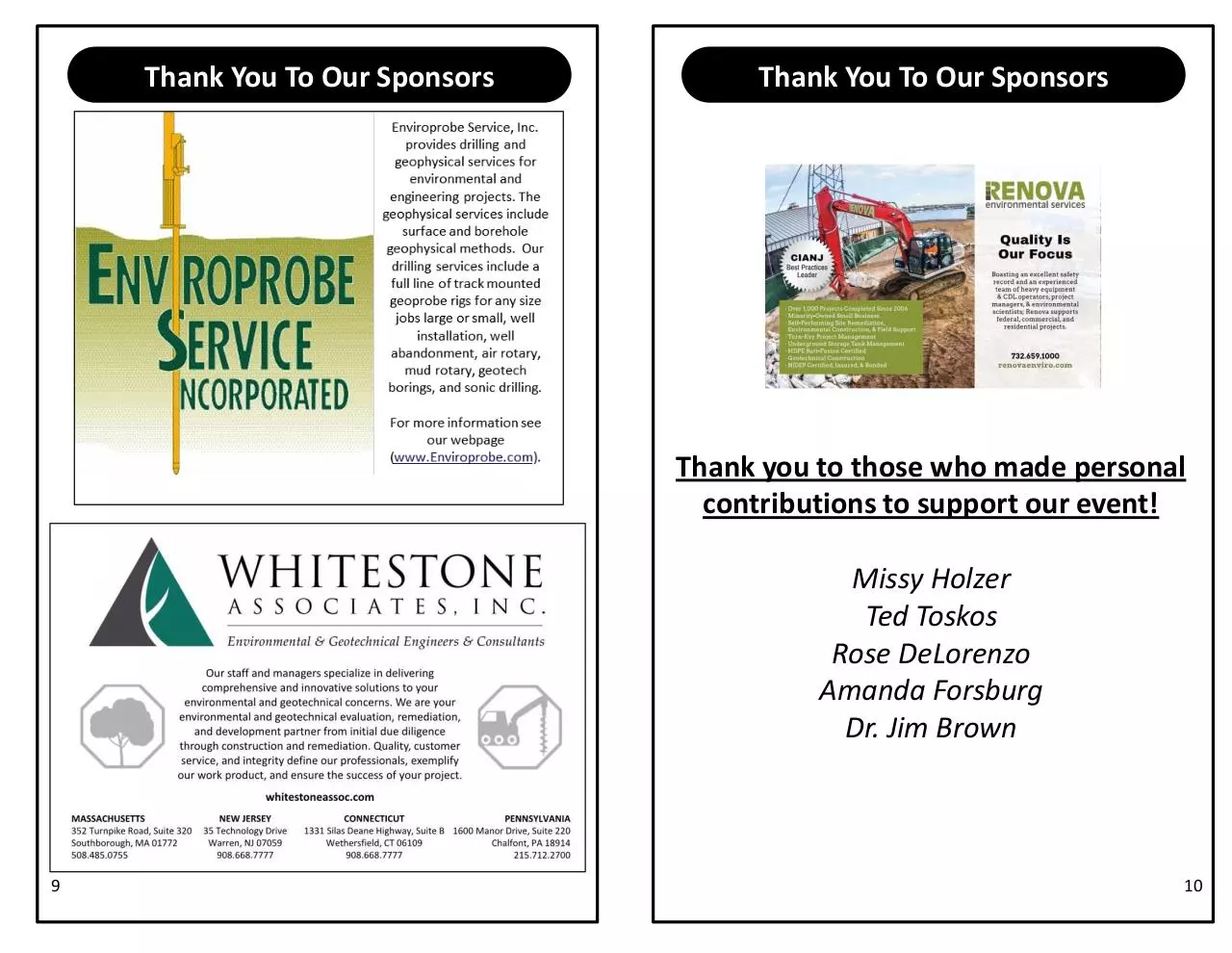Meeting Program 2017 Rev1 Online View (PDF)
File information
Title: Slide 1
Author: Amanda
This PDF 1.5 document has been generated by Microsoft® PowerPoint® 2010, and has been sent on pdf-archive.com on 10/05/2017 at 04:35, from IP address 73.188.x.x.
The current document download page has been viewed 362 times.
File size: 927.52 KB (6 pages).
Privacy: public file





File preview
Association of Environmental &
Engineering Geologists
New York – Philadelphia Chapter
http://www.aegnyp.org/
Oral Presentation
“The Effects of Tide Gates on the Distribution of Heavy
Metals in Sediment”
Presented by Alexander A. Cid, Hudson County
Community College
Third Annual Student Night
Clarion Hotel, Somerset, NJ
Thursday, March 30, 2017
Connecting students
and practicing professionals.
Heavy metal distribution within sediment is studied to
understand where pollution is gathering or spreading due to
tides and floods. Tide gates restrict the flow of the river inland
during high tide and open during low tide to even the water
levels. The study was to assess the effects of two different
types of tide gates and with two different land areas which are
associated with each tide gate. Acorn Road Creek Tide Gate is a
simple metal flap tide gate which affects an area around 91
acres and is mostly residential. Losen Slote Tide Gate is a threepump system tide gate which affects an area of around 671.4
acres and is a complex system of indusial wetlands commercial
and residential land use. Twelve samples were collected from
each Tide Gate, six on the landside and six on the riverside. The
samples were then put though an ICP-MS to calculate the
concentration levels of 27 heavy metals. Out of the 27 metals
12 were studied as the Priority Metal. The data showed that
the concentration of these Priority Metals were all higher on
the landside for both Tide Gates, Losen Slote showing a greater
variant of difference. Regression analysis showed that Losen
Slote’s landside has a negative slope for almost all the metals,
starting at the Tide Gate and moving inland. This suggests that
there is a buildup of heavy metals in the landside of some Tide
Gates, concluding that Tide Gates have an effect on heavy
metal distribution in sediment. While this study compared two
different Tide Gates and areas, further studies of similar tide
gates and/or of similar area land usage while show the levels of
variants found with in this study.
2
Oral Presentation
“The Relationship Between Dune Morphodynamics and
Economic Values Along the New Jersey Shoreline”
Oral Presentation
“Magnetic Susceptibility (MS) and X-Ray Diffraction
(XRD): A Geophysical Way to Track Microbial Activities in
a Bio-remediated Polluted Site”
Presented by Jesse Kolodin, Montclair State University
Since Superstorm Sandy, The US Army Corps of Engineers has
constructed several dune and berm features along the New
Jersey coastline to protect barrier island communities from
future storm impacts. A basic management question is
whether the benefits generated by these projects justify the
costs.
To tackle this question, we have developed a
morphodynamic model of the evolution of coastal dunes that
accounts for both sediment erosion and overwash during storm
events.
The model investigates two coastal protection
measures: dune nourishment to control erosion and sediment
relocation to control overwash. In the model, the levels of
protection measures reflect choices made by a coastal property
owner, where property value is positively correlated with both
a proximate dune’s height and its distance from the property.
We derive mathematical expressions for optimal dune size and
location as a function of geologic and economic parameters.
Model results suggest that both the costs of nourishment and
baseline property values can play key roles in determining the
optimal cross-sectional area that a dune system should
maintain in the long-term. In a case where a group of coastal
townships with different nourishment costs and property
values need to coordinate their protection measures to
maintain the same dune geometry along a common coast, this
framework could be used to develop formulas for sharing total
project costs or for allocating government subsidies. Future
work will explore the “geo-economic” effects on ocean views
that may be diminished by a dune system of particular size and
location.
3
Presented by Yonesha Donaldson, Rutgers University Newark
From an unknown date until 1955, the Brandywine facility
(Maryland) was a Department of Defense owned storage yard
for surplus equipment, drums of waste solvents, and
polychlorinated biphenyl (PCB) products. Due to the
uncontrolled and abandoned wastes, Brandywine was
recognized as a National Priority and eligible for federal
cleanup funds.
One treatment employed at this site consists of an anaerobic
reductive dehalogenation where molasses was injected into
the ground to grow microorganisms that can convert the
Volatile Organic Compounds (VOCs) to non-hazardous ethene.
Indeed, such microorganisms can act as catalysts of chemical
reactions occurring at the interface between the electrolyte
and the grains, creating iron as a bi-product.
Magnetic susceptibility (MS) is a geophysical method that can
detect these bi-products as it is particularly sensitive to the
presence of magnetic metallic particles. X-Ray diffraction (XRD)
is a destructive technique used for phase identification of a
crystalline material. Together, both magnetic susceptibility and
X-Ray Diffraction identify and confirm the presence of Ironbearing minerals resulting from microbe-mediated redox
reactions. By tracking these bio-products of microbial activity,
we have assessed the efficiency of the bioremediation
technique used in Brandywine to detect the extent of the
4
treatment area.
Poster Session
Poster Session
“Using Remote Sensing Techniques to Assess Rockfall
Risks at Delaware Water Gap” – Presented by William
Akin, University of Pennsylvania
“A Targeted Approach to Identifying Land Suitable for
Green Stormwater Infrastructure Projects to Decrease
Combined Sewer Overflows in the City of Chester,
Pennsylvania” – Presented by Sara Labrum, University of
Pennsylvania
“Comparing Adsorption of (NH4+)(aq) and NH3(g) onto
Struvite and its Heat-Treated Decomposition Products” –
Presented by Dayana Arrue, Rutgers University-Newark
“Extent of Heavy Metal Contamination in an Urban
Community Garden in Newark, New Jersey” – Presented
by Erika Damacela, Rutgers University-Newark
“Phytoremediation of Zinc (Zn) using Poplar Deltoides
Plants” – Presented by Tricia Defreitas, Rutgers
University-Newark
“Hydrology of the Tarkhill Creek in Pike County,
Pennsylvania” – Presented by Brooke Durnin, Widener
University
“Long Term Changes of Above- and Below-ground
Biomass in Natural and Restored Salt Tidal Wetlands
(2009-2016)” – Presented by Michael Kirtz, Jr., Rutgers
University-Newark
“Magnetic Susceptibility: Correlations with Clay Content
and Apparent Diffusion Coefficients Controlling Electrical
Double Layer Polarization” – Presented by Tonian
Robinson, Rutgers University-Newark
5
“Using Ground Penetrating Radar to Quantify Vegetation
Volume in a Eutrophying Lake in the Poconos” –
Presented by Taylor Mantey, University of Pennsylvania
“SP Signals Response to Water Table Change in
Hydrocarbon Contaminated Soil Media” – Presented by
Mina Soliman and Youssef Rizk, Rutgers University –
Newark
“The Assessment of Phosphate, Nitrate, and Ammonium
Concentrations within Urban Water Setting” – Presented
by Allison Waldron, Rutgers University - Newark
“The Sorption of Tetracycline and Sulfamethazine by
Struvite” – Presented by Ann Walker, New Jersey
Institute of Technology
“What’s in your water?” – Presented by Brittany
Washington, Rutgers University - Newark
“Combining Geographic Information Systems Technology
and Rock Mechanics to Analyze the Spatial Distribution
of Abandoned Coal Mines and Their Risk of Mine
Subsidence in Scranton, Pennsylvania” – Presented by
Taunee Werts and James Riggs, University of
Pennsylvania
6
Thank You To Our Sponsors
7
Thank You To Our Sponsors
8
Thank You To Our Sponsors
Thank You To Our Sponsors
Thank you to those who made personal
contributions to support our event!
Missy Holzer
Ted Toskos
Rose DeLorenzo
Amanda Forsburg
Dr. Jim Brown
9
10
AEG NY-P Thanks You!
Thank you to everyone who contributed their time and effort
to coordinate a successful Student Night!
A BIG THANK YOU to the students who presented this
evening!
Remember: Students join for FREE.
AEG offers many opportunities for students, including: online
resources, publications, annual meetings, section meetings,
seminars,
networking,
scholarship
and
career
resources. Participating in meetings enables students to
interact with practicing professionals and is a great way for
students to learn more about applied geology.
Visit
“Join/Renew” at www.aegweb.org and fill out the
Complimentary Student Membership application.
New York-Philadelphia Board:
Chairperson: Rose DeLorenzo, Matrix New World
Vice Chair: Curt Schmidt, H2M
Treasurer: Niall Henshaw, Parsons
Secretary: Amanda Forsburg, Langan
Committee Chairs:
Bylaws Chair: Ted Toskos, Amec Foster Wheeler
Programming Chair: Jim Peterson, Princeton Geoscience, Inc.
Social Media Co-Chair: Rami Abousleiman, MFS Consulting
Engineers
Social Media Co-Chair: Jennifer Cherlin, Amec Foster Wheeler
Student Outreach Co-Chair: Rami Abousleiman, MFS Consulting
Engineers
Student Outreach Co-Chair: Alexander Gates, Rutgers-Newark
Field Trip Chair: Niall Henshaw, Parsons
Newsletter Editor: Brionna O’Connor, Princeton Geoscience, Inc.
11 Are you interested in getting involved? Let us know! Email us
at aeg.nyp@gmail.com.
Download Meeting Program - 2017 Rev1 - Online View
Meeting Program - 2017 Rev1 - Online View.pdf (PDF, 927.52 KB)
Download PDF
Share this file on social networks
Link to this page
Permanent link
Use the permanent link to the download page to share your document on Facebook, Twitter, LinkedIn, or directly with a contact by e-Mail, Messenger, Whatsapp, Line..
Short link
Use the short link to share your document on Twitter or by text message (SMS)
HTML Code
Copy the following HTML code to share your document on a Website or Blog
QR Code to this page

This file has been shared publicly by a user of PDF Archive.
Document ID: 0000594643.